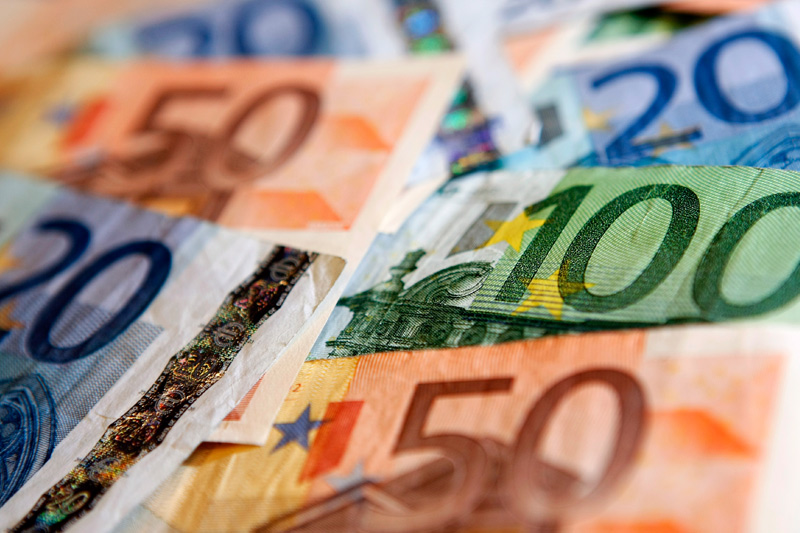Investing.com - The euro was mixed to broadly lower against its global counterparts on Tuesday, as concerns over the ongoing sovereign debt crisis in peripheral euro zone nations and worries over the global economic recovery weighed.
During European late morning trade, the euro was down against the U.S. dollar, with EUR/USD sliding 0.31% to hit 1.3065.
Concerns over Spain’s high borrowing costs intensified earlier, as the yield on 10-year government bonds climbed to 5.8%, the highest level since early December amid fears that the country will be the next in the euro zone to require a bailout.
Sentiment on the single currency was also hit following a report showing that investor sentiment in the euro zone dropped this month, after three successive monthly increases.
Market research group Sentix said its index of investor confidence declined by 6.5 points to minus 14.7 in April from March’s reading of minus 8.2.
Analysts had expected the index to improve modestly by 0.1 points to minus 8.1 in April.
Meanwhile, Friday’s weaker-than-forecast U.S. employment data continued to cast doubts over the strength of the country’s economic recovery.
The single currency edged higher against sterling, but remained within striking distance of a three-month low, with EUR/GBP inching up 0.08% to hit 0.8256.
The pound found support after industry data showed that U.K. house prices declined at the slowest pace since June 2010 in March.
The Royal Institution of Chartered Surveyors' seasonally adjusted house price balance rose to minus 10 from minus 13 in February, beating forecasts for a more modest rise to minus 12.
The report came after robust data on the manufacturing, construction and service sectors last week eased concerns over a possible recession in the U.K.
The euro was down against the broadly stronger yen, with EUR/JPY shedding 0.59% to hit 106.16.
Earlier Tuesday, the Bank of Japan refrained from implementing further easing measures and left its benchmark interest rate unchanged close to zero, in a widely anticipated decision.
The euro edged higher against the Swiss franc, with EUR/CHF inching up 0.07% to hit 1.2028.
The shared currency was mixed against the Canadian, Australian and New Zealand dollars, with EUR/CAD losing 0.15% to hit 1.3053, EUR/AUD dipping 0.03% to hit 1.2704 and EUR/NZD adding 0.32% to hit 1.5999.
Sentiment on the growth linked Australian and New Zealand dollars was dented earlier after official data showed that Chinese imports declined sharply in March.
China posted a trade surplus of USD5.35 billion last month, as imports grew just 5.3% after increasing by 39.6% in February. China is Australia’s largest and New Zealand’s second largest export partner.
Also Tuesday, official data showed that French industrial production rose by 0.3% in February, slightly more than expectations for a 0.2% increase, easing concerns over the economic outlook for the euro zone’s second largest economy.
During European late morning trade, the euro was down against the U.S. dollar, with EUR/USD sliding 0.31% to hit 1.3065.
Concerns over Spain’s high borrowing costs intensified earlier, as the yield on 10-year government bonds climbed to 5.8%, the highest level since early December amid fears that the country will be the next in the euro zone to require a bailout.
Sentiment on the single currency was also hit following a report showing that investor sentiment in the euro zone dropped this month, after three successive monthly increases.
Market research group Sentix said its index of investor confidence declined by 6.5 points to minus 14.7 in April from March’s reading of minus 8.2.
Analysts had expected the index to improve modestly by 0.1 points to minus 8.1 in April.
Meanwhile, Friday’s weaker-than-forecast U.S. employment data continued to cast doubts over the strength of the country’s economic recovery.
The single currency edged higher against sterling, but remained within striking distance of a three-month low, with EUR/GBP inching up 0.08% to hit 0.8256.
The pound found support after industry data showed that U.K. house prices declined at the slowest pace since June 2010 in March.
The Royal Institution of Chartered Surveyors' seasonally adjusted house price balance rose to minus 10 from minus 13 in February, beating forecasts for a more modest rise to minus 12.
The report came after robust data on the manufacturing, construction and service sectors last week eased concerns over a possible recession in the U.K.
The euro was down against the broadly stronger yen, with EUR/JPY shedding 0.59% to hit 106.16.
Earlier Tuesday, the Bank of Japan refrained from implementing further easing measures and left its benchmark interest rate unchanged close to zero, in a widely anticipated decision.
The euro edged higher against the Swiss franc, with EUR/CHF inching up 0.07% to hit 1.2028.
The shared currency was mixed against the Canadian, Australian and New Zealand dollars, with EUR/CAD losing 0.15% to hit 1.3053, EUR/AUD dipping 0.03% to hit 1.2704 and EUR/NZD adding 0.32% to hit 1.5999.
Sentiment on the growth linked Australian and New Zealand dollars was dented earlier after official data showed that Chinese imports declined sharply in March.
China posted a trade surplus of USD5.35 billion last month, as imports grew just 5.3% after increasing by 39.6% in February. China is Australia’s largest and New Zealand’s second largest export partner.
Also Tuesday, official data showed that French industrial production rose by 0.3% in February, slightly more than expectations for a 0.2% increase, easing concerns over the economic outlook for the euro zone’s second largest economy.
